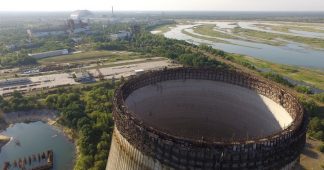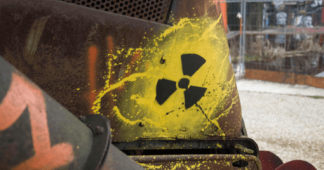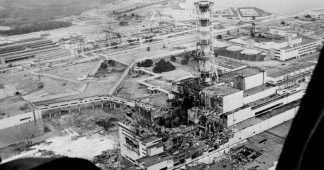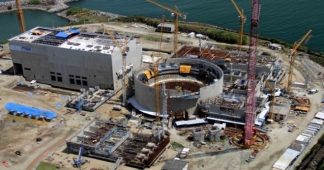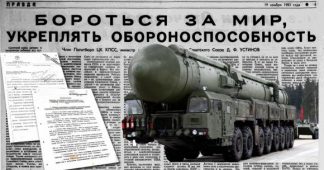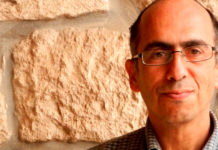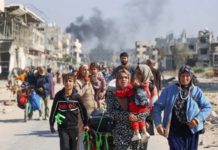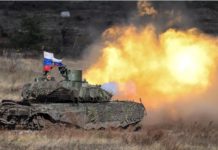by Svetlana Savranskaya
Washington, D.C., May 15, 2020 – The Soviet Politburo knew as soon as July 1986 that the design of the Chernobyl reactor was at fault in the deadly explosion there the previous April, not just the errors made by reactor staff, according to documents published today for the first time in English by the National Security Archive.
The documents include the extremely important Politburo discussion of Chernobyl on July 3, 1986, when the head of the investigative commission, Boris Shcherbina, clearly stated that it was not just the violations of rules committed by the staff that led to the explosion, but that “RBMK reactors are potentially dangerous” in their very design. Shcherbina called for halting further construction of such reactors (Document 1).
The Shcherbina report gives a deeply critical analysis of the situation throughout the Soviet nuclear power industry and shows that shortcuts had been made that led to serious safety issues and numerous smaller accidents. Although the subsequent Politburo discussion featured attempts to avoid responsibility and to find scapegoats, this document also shows the impact of Mikhail Gorbachev’s policy of glasnost—one hears an unusual amount of disagreements and questioning of the party leadership itself.
Other important documents in today’s posting, which is the second installment in the Archive’s series focusing on Chernobyl evidence (Volume 1), include the initial analysis of radioactive contamination in Sweden, which was the first signal internationally of the Chernobyl accident, Soviet internal discussions of the causes of the accident, and the first signs of domestic opposition in the Soviet Union to the culture of secrecy surrounding all information about the accident.
The Soviet documents published here in translation for the first time show the monumental efforts by the military and civilian services to contain the reactor fire, evacuate citizens, and decontaminate the area. This was a public health emergency of a kind the USSR was utterly unprepared for and once its scope was fully appreciated it prompted a huge government effort to come to grips with the consequences.
The State Hydrometeorological Committee and the Ministry of Health produced reports on the effects of radiation on citizens and levels of contamination of water and agricultural resources, closely monitoring the changing situation on the ground. The Ukrainian Ministry of Health reported to the Union Ministry of Health on extensive programs of medical oversight, testing and treatment of evacuees, nutrition programs, and monitoring of children, who absorbed more of the damaging radiation than other groups.
Truly heroic work by the Soviet military—22,500 conscripts by the end of 1986—is presented in the report by Marshal Sergey Akhromeyev, chief of the Soviet General Staff and the person in charge of the military “liquidation” effort (Document 5). According to the continually growing documentary record, the same system that was initially unprepared for a disaster of this scale, was able to respond quickly and to concentrate all its resources on containment and cleanup of the accident.
At the same time, the shock of Chernobyl in the atmosphere of glasnost promoted by Gorbachev led to widespread grass-roots expressions of discontent and criticism of the government response. In a letter to Pravda that was forwarded to the Politburo, a group of “liquidators” describes the lack of medical care and the attitude of neglect from local party and government organs. In November 1988, Academician Andrei Sakharov addressed Gorbachev directly in a letter where he complained about the lack of glasnost and “obstruction” of a publication about Chernobyl by a nuclear engineer who was involved in mitigation of the accident (Document 9). And in 1989, an independent group of “liquidators” in Ukraine attempted to organize a Union-wide organization of “liquidators” that would monitor the cleanup work and even carry out oversight of how the resources disbursed for the Chernobyl mitigation were used by the local administration.
The documents posted here show that notwithstanding an unprecedented effort by Soviet scientists to understand the dangers made stark by the Chernobyl accident, the level of knowledge was still incomplete and often the long-term consequences were underappreciated. For example, in January 1992, a U.S. congressional delegation met with the Vice President of the Russian Academy of Sciences, Academician Evgeny Velikhov, who was one of Gorbachev’s advisers on Chernobyl. According to the cable from U.S. Embassy in Moscow on the meetings of the Codel, when asked about the progress of Chernobyl cleanup,
“Velikhov said that the Chernobyl situation is not as bad as the press says, claiming that low doses of radiation fluctuate more than envisioned and that health dangers are overstated. He cited studies in the Southern Ukraine related to the early warning radar system stating that most illness in this region is due to stress. In Chernobyl, he said, children suffered thyroid problems and other non-cancerous illnesses due to quick iodine emission, but the Soviet record shows there is no record of increased cancer cases. When asked if Chernobyl has been cleaned up, Velikhov responded negatively, saying there is still a thirty-kilometer non-populated zone, which is contaminated by cesium and strontium and which will take a long time to decontaminate. Otherwise, there are local spot concentrations outside the zone. Based on experience from the Urals (Kyshtym), the area will be more or less safe after thirty years, he said.”[1]
The following essays were contributed by two members of the Russia Program staff based on research in the documents in today’s posting.
* * *
The Liquidators
by Sarah Dunn
Research Assistant, Russia Program, the National Security Archive
In October of 1986, a group of liquidators, a colloquial term for those officially called “participants in the elimination [or liquidation] of the consequences of the accident at the Chernobyl nuclear power plant,” wrote a letter to the Central Committee of the Communist Party of the Soviet Union from a sanatorium in the Kharkov region of Ukraine. In this letter, the men spoke of their concerns about the impact of the winter on their health (“The worsening weather conditions increase the likelihood of the emergence of every kind of cold-related disease….And what their consequences will be is still unknown.”), their lack of weather appropriate clothing (“The clothes in which we arrived at the sanatorium in the summer are no longer suited to the season and to buy ‘normal’ warm things in our situation is practically impossible.”), and the poor medical treatment they were receiving (“…medical conditions are not being checked by specialist doctors familiar with radiation sickness, and such regular medical check-ups are not provided.”) (Document 4) The men spoke of inadequate nutrition, the failure to provide them with the housing and funds they had been promised, poor treatment by government organizations that were meant to be helping them, the feelings of unjustness that came from hearing on the radio of the benefits given to the evacuees of the 30-km exclusion zone, and their difficulties in performing everyday tasks, like standing in a line for bus tickets, due to their radiation sickness.
Exact statistics for the health and mortality rates of the liquidators are unknown. There were around 600,000 liquidators who worked at Chernobyl from 1986 to 1990[2]. The highest radiation doses were received by the 240,000 liquidators who were within the 30-km exclusion zone from 1986 to 1987, with the average radiation dose in 1986 estimated to be 170 millisieverts (mSv)[3][4]. For reference, the legal limit set by the Nuclear Regulatory Commission for the radiation dose for an entire year for radiation workers is 50 mSv[5]. A 2005 United Nations study said that fewer than 50 deaths could be directly attributed to radiation related to Chernobyl at the time, and said that 4,000 deaths could be expected among liquidators and evacuees[6]. Greenpeace stated that Chernobyl had caused 200,000 deaths from 1990-2004, and spoke of other effects from the radiation, like premature aging and psychological disorders. As of 2016, the Ukrainian Health Ministry suggested that 20,000 liquidators die from “Chernobyl related illnesses” each year4.
In a resolution of the Central Committee, signed by then General Secretary Mikhail Gorbachev, the liquidators’ letter was described as bearing “witness to the facts of an unacceptably heartless, bureaucratic attitude” shown to them in their attempts to organize treatment and welfare support. Twenty years later, Gorbachev wrote about Chernobyl as a “historic turning point,” as the disaster, which “more than anything else, opened the possibility of much greater freedom of expression, to the point that the system as we knew it could no longer continue.”[7]
The liquidators’ difficulties did not end with the Central Committee’s resolution. To this day many liquidators face struggles in obtaining the medical treatment and compensation they are owed by their governments. Despite their health issues, financial struggles, and psychological stress, many liquidators did not regret their work then, and do not regret it now. In their letter, the liquidators spoke of their pride at having helped avert disaster at Chernobyl, speaking of their pride at not having suffered in vain. Sergey Krasilnikov, a now 65-year-old former liquidator, spoke about his health issues and his time at Chernobyl in 2016, and said “Had I known with what indifference and scorn the state would treat me now, I may not have agreed to be a liquidator. Nevertheless, knowing what I know now, I would probably act in a similar way.”[8]
* * *
The Role of International Actors in Revealing the Environmental Impact of Chernobyl
by Brooke Lennox
Summer Intern at the National Security Archive (2019)
In order to better understand the impact of the massive catastrophe that happened at the Chernobyl Nuclear Power Station, one needs to look at the contribution made by other countries and international organizations in collecting and making public information about the spread of contamination. International actors were critical to the discovery of the accident but also deserve a significant amount of credit for the measures taken to protect citizens in their countries and attempts to prevent further contamination.
The first country to discover the environmental effects caused by the explosion was Sweden. As shown in the two documents in this posting on Sweden’s role in developing the international understanding of what happened in the USSR on April 26, 1986, radioactive dust had already traveled 900 miles from the explosion site in around 24 hours. Experts in Stockholm were able to figure out almost entirely what had happened and then share this critical news with the world (Document 3).
As soon as scientists in Sweden determined the seriousness of the accident they took a number of steps including implementing bans on certain products and measuring food’s cesium levels. The rapid attention that was given to Sweden’s own citizens not only confirms the seriousness of the event’s effects on the surrounding environment but also shows the disparity in effort and preparedness between the Soviet Union and Western Europe after the accident.
Sweden’s serious response to the explosion was instrumental in limiting the effects of Cesium-127 in their local environment. Despite the necessity for swift action, the lack of information and the inability of local actors to act independently without orders from Moscow significantly delayed preventative measures in the USSR.
In contrast, Sweden calmly determined the nature and scope of the problem within two days of the accident and immediately took action including informing the rest of the international community.
Various international actors actively participated in the decontamination of Chernobyl and its surrounding areas. However, even today, more than 30 years after the accident, international actors are still part of the story of Chernobyl. For example, in Belarus scientist Bandazhevsky was put in jail in 1999 for his continued research on the effects of Cesium-137, one of the main contaminants produced by Chernobyl. His work was banned because the Belarusian government wanted to continue using agricultural lands despite the evidence of continued contamination. Bellona, an international environmental NGO, has worked on Bandazhevsky’s case and many other cases connected to the damage done by Chernobyl.
Over the years, international actors like Bellona collected invaluable evidence of Chernobyl’s massive environmental impact, whether it be Cesium levels or a continuously contaminated food chain. These effects were never limited to Ukraine or the territory that used to be the USSR. The impact of Chernobyl and the cooperation between governments and non-governmental actors in discovery, decontamination, and analysis highlight the need for more cross-border transparency and cooperation in the sphere of peaceful nuclear energy.
The documents
Document 01
CC CPSU Politburo Discussion of the Accident at the Chernobyl Nuclear Power Station. Top Secret. Only copy.
1986-07-03
Source: Archive of the President of the Russian Federation (APRF), Record of Session of the CC CPSU Politburo, 3 July 1986, working copy, excerpts published in Rudolph Pikhoia, Sovetskii Soyuz: Istoriya Vlasti, 1945-1991 (Novosibirsk: Sibirskii Khronograph, 2000), pp. 434-437
Excerpts from the official top secret working copy of this Politburo session were partially published by Rudolph Pikhoia, the first head of the Federal Archival Service of the Russian Federation. The following excerpts include a full presentation by Boris Shcherbina, in which he reports on the findings of the State Commission created to investigate the causes of the Chernobyl accident. He clearly identifies two main causes—gross violations of security procedures committed by the station’s staff, but also flaws in the design of the reactor. He tells the Politburo that RBMK nuclear reactors working in the USSR, but also sold to socialist countries, “were incompatible with modern safety requirements.” The report reveals a shocking picture of failures in the Soviet nuclear energy industry: “During the 11th five-year plan, there were 1042 emergency shutdowns of power blocks, among them 381 at nuclear power stations with the RMBK reactor.” Shcherbina names specific agencies and individuals as being responsible for the accident: “The Commission believes that the Ministry of Medium Machine Building (Minister cde. Slavsky), its Institute of Power Technologies (the main designer of the reactor), and the Kurchatov Institute of Nuclear Power (scientific advisor) also bear responsibility for the accident. The designers who worked on this reactor (cdes. Dollezhal, Yemelyanov), did not ensure the required level of safety of the RMBK reactor, and did not evaluate its reliability with a critical eye.” The report prompts significant discomfort among the Politburo members and invited experts present.
This document presents a fascinating account of a rare “fight” at the Politburo, where representatives of various agencies tried to shift blame onto one another and protect their turf. Gorbachev blasts the nuclear industry leadership and academic scientists for making the wrong decisions, especially regarding placing nuclear power stations close to cities—as if they had not been considered and approved by the party leadership and the Politburo itself
Document 02
Central Intelligence Agency (CIA) Report: Collection on Chernobyl Disaster
1986-07-31
Source: CIA Freedom of Information Act release
This is a heavily redacted memo to the Director of the CIA from the deputy director for weapons and scientific research, produced at the DCI’s request soon after the accident. The report contains an assessment of information available about the Chernobyl and other RBMK reactors before the incident and the timeline of discovery across Europe, specifically in Sweden and the United States, which shows that the CIA only learned about the accident on April 28—first from Sweden and then from the official Soviet announcement. The memo concludes that more information on the incident should be collected and suggests a number of steps to improve responsiveness to future crises. Although the memo is heavily redacted, one can see that the Agency was not fully satisfied with its collection efforts on Chernobyl.
Document 03
Chernobyl—Its Impact on Sweden
1986-08-01
Source: National Institution of Radiation Protection, Statens Stralskydd Institut.
This is the first comprehensive publication in English on Chernobyl’s effect on Sweden. The report reviews the early detection of signs of radioactivity, the collection and analysis of data by the Swedish Radiation Protection Institute and its notification of Swedish and local authorities. It outlines the emergency measures taken in Sweden after increased radiation levels were noticed. The document also explains in detail actions taken by the Swedish government to inform the public and to protect its citizens from radiation poisoning. An interesting finding of the report is that “the general public was not always satisfied with the information provided by the authorities, in spite of complete openness,” because information changed as new data was incorporated, confusing measurements were used, and the public did not fully trust the conclusions, especially in the early period after the accident.
Document 04
CC CPSU Resolution on a Letter from a group of participants of the liquidation of the accident at the Chernobyl Nuclear Power Station [Translation]
1986-10-30
Source: Russian and Eastern European Archives Documents Database . Russian State Archive of Contemporary History, Fond 89, p. 53, d. 21.
This document contains a letter from a group of the participants in the liquidation of the accident at Chernobyl, commonly referred to as “liquidators,” and a CC CPSU Resolution demanding that their problems be addressed immediately. In an unusually emotional tone, the resolution describes the way the liquidators have been treated as “unacceptably heartless.” In the letter, the liquidators describe their current poor health as a result of various forms of radiation sickness and its probable long-term consequences, their poor treatment in a sanatorium, and the lack of promised compensation and housing. The undersigned complain about their inability to obtain even basic things like warm clothing for the winter and medications prescribed by their doctors. The letter was sent to the chief editor of Pravda, Viktor Afanasiev, who submitted it to the Politburo
Document 05
Akhromeyev report to CC CPSU on progress of decontamination around Chernobyl [Translation]
1986-12-01
Source: Source: Russian and Eastern European Archives Documents Database. Russian State Archive of Contemporary History, Moscow, Russian Federation. Fond 89 opis. 53 d. 50
This report from Soviet Chief of General Staff Marshal Sergey Akhromeyev outlines the progress of the cleanup and decontamination by the Soviet military. One can see the enormity of the task and the systematic approach organized by Akhromeyev who was assigned to lead the military mitigation effort. Special construction troops decommissioned toxic areas including housing, areas around the nuclear power plant, and in the city of Pripyat’s neighborhoods. A table within the report further shows the progress of the decontamination efforts. The scale is truly staggering: 22.5 thousand servicemen and 6.5 thousand units of equipment were involved in the cleanup. The Soviet Air Force conducted 18,818 flights, “decontaminated around 2500 hectares of land, delivered 52,978 tons of special liquids, and transported 25,500 thousand people and more than 5.5 thousand tons of cargo.”
Document 06
Report from Ukrainian Ministry of Health to USSR Minister of Health Chazov [Translation]
1987-05-26
Source: Russian and Eastern European Archives Documents Database. Russian State Archive of Contemporary History, Moscow, Russian Federation. Fond 89 opis 56 d. 7
In this report to the Ministry of Health of the USSR, Ukrainian Minister of Health A.E. Romanenko reviews measures undertaken by the Ukrainian public health system to mitigate the health consequences of the Chernobyl accident. The report presents a picture of wide-spread screening of the population living in areas of elevated radiation levels and a truly gigantic effort to examine and treat those who suffered damage to their health. All medical institutions and research institutes both at the republican level and locally were involved in testing and public education work. Special attention was paid to the health situation of children, who were tested for thyroid damage at least 2-3 times in 1986 alone. Special standards for nutrition and free food were approved for children, although, the report shows, they were sometimes violated. The Ukrainian Health Minister informs Minister Chazov that doctors, nurses, paramedics, and medical students all have been sent to help.
Document 07
The Soviet Nuclear Power Program After the Chernobyl Accident. SOVA Research Paper
1987-06-00
Source: CIA Freedom of Information Act release
This previously secret report analyzes the Soviet response to the Chernobyl accident and its impact on the future of Soviet energy production. The report confirms the economic downturn in the energy sector for the USSR in the months after the explosion, but adds that the USSR still has big plans for nuclear energy despite the accident. The Soviet leadership is committed to reducing the country’s dependence on oil and gas, substantial investment in the nuclear energy had been made, and the “antinuclear elements of public opinion will have only a week effect.” Out of the 35 planned reactors to be built between 1986-1990, the incident only set the USSR back 4-5 reactors because 80 percent of reactors being planned or currently under construction were to be of a new newer type. The RBMK reactors that will remain in use will be fixed to add safety features. The report provides a succinct explanation of the causes and consequences of the accident, a timeline, and a description of the cleanup efforts. In terms of human costs, it mentions 31 initial casualties and more than 300 people requiring hospitalization, but predicts that in the long term “the overall statistical increase in cancer rates is likely to be minimal.” (Other estimates would vary greatly. For instance, Greenpeace concluded that 200,000 deaths could be attributed to the accident between 1990-2004.)
Document 08
On the Radiation Situation Caused by the Accident at the Chernobyl NPP. Map of radiation levels [Translation)
1987-07-01
Source: Russian and Eastern European Archives Documents Database . Russian State Archive of Contemporary History, Fond 89, op. 56, d. 10.
The State Hydrometeorology Committee reports on the radiological situation in the area contaminated by the Chernobyl accident. More than a year has passed since the accident and the radiological situation has stabilized—it has not changed significantly between June 15 and 30. The levels of radiation in the main rivers of the Dnepr waterbasin has remained within the permissible levels established by the Health Ministry. The situation with radiation in Moscow remains “favorable.” The report includes a map of radiation levels in the Ukrainian Soviet Socialist Republic (SSR), Belorussian SSR, and the Russian SSR on July 1, 1987. The map shows the radiation measurements in milliroentgen/hour, as well as the 30-km exclusion zone around the Chernobyl nuclear power plant. The legend includes a guide to the danger of different levels of radiation.
Document 09
Letter from A.D. Sakharov to M.S. Gorbachev [Translation]
1988-11-04
Source: Russian and Eastern European Archives Documents Database . Russian State Archive of Contemporary History , Fond 89, op. 53, d. 81.
In this letter to Mikhail Gorbachev, nuclear physicist and dissident Andrei Sakharov objects to the exclusion of public opinion from the formulation of nuclear energy policy in the USSR. Sakharov writes about the obstruction of the publication of G.U. Medvedev’s novel The Chernobyl Notebook, and his belief that it is essential that all citizens of the USSR know “all the circumstances of the Chernobyl disaster.” He insists it is illogical for those outside of the Soviet Union to know more about what happened in the USSR than Soviet citizens. Sakharov notifies Gorbachev that he “will act so that [this work] is broadly known” to the international community.
Document 10
Kiev Oblast Party Committee Report to the CC CPSU on an Attempt to Create an Independent Organization of Liquidators. [Translation]
1989-04-12
Source: Russian and Eastern European Archives Documents Database . Russian State Archive of Contemporary History , Fond 89, opis. 53, d. 82.
In this report to the Central Committee from the Kiev oblast committee to the CC CPSU, information is provided about an effort to create an independent advocacy group of workers who helped to liquidate the effects at Chernobyl. The report contains a biography on the founder, Grigory Lepin, (with three previous party reprimands) and discusses the group’s goals, which include creating a network of primary organizations, holding regular conferences, and assisting with social welfare issues. The most problematic issue with the group charter is that it plans to carry out “effective oversight of the effectiveness of the work to eliminate the consequences of the accident at the Chernobyl NPS, including oversight of the use of funds disbursed for these purposes.” The Slavutich city party committee deemed creation of such a committee “inexpedient” because of the lack of support among workers and did not approve the convening of the founding conference. The planned event never took place.
Notes
[1] U.S. Embassy Moscow cable to Secretary of State, Subject: Codel Exon Meeting with Russian Academician Velikhov, 30 January 1992, State Department F-2014-10853.
[2] Chernobyl: Assessment of Radiological and Health Impact 2002 Update of Chernobyl: Ten Years On. Chapter IV. Dose estimates. The Nuclear Energy Agency.
[3] Health effects of the Chernobyl accident: an overview. WHO. April 2006.
[4] How much radiation is too much? A handy guide. By Brianna Lee, Need to know on PBS. March 22, 2011.
[5] Regulatory Dose Limits. Health Physics Society.
[6] Liquidators Live With Legacy Of Chernobyl. By Christian Borys, Radio Free Europe/Radio Liberty, April 23, 2016
[7] Turning point at Chernobyl. By Michail Gorbachev, The Japan Times. April 21, 2006.
[8] The ‘liquidator’: He cleaned up after Chernobyl — and is paying the price. By Kim Hjelmgaard, USA TODAY. April 17, 2016.
